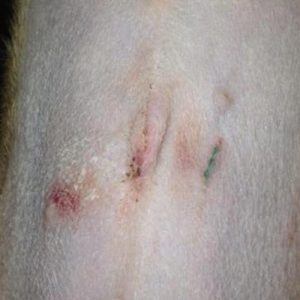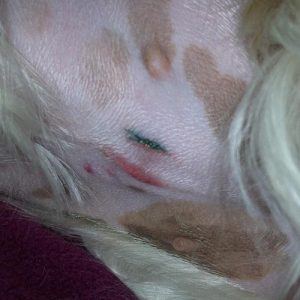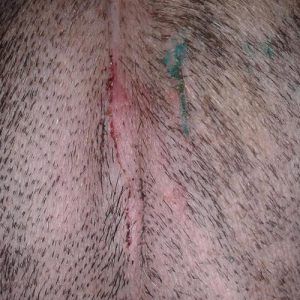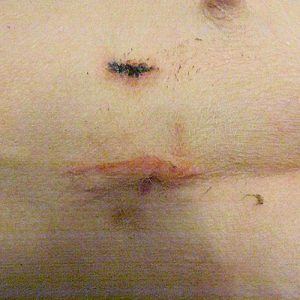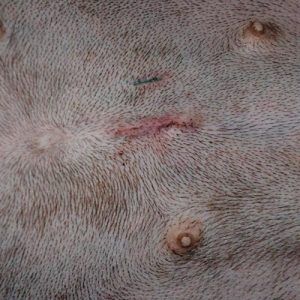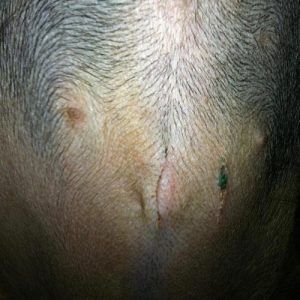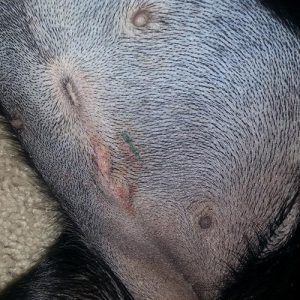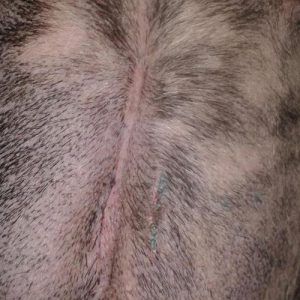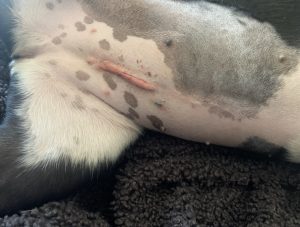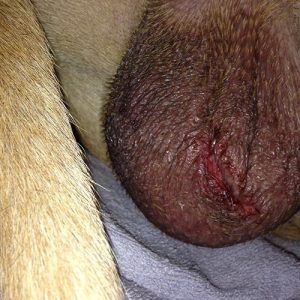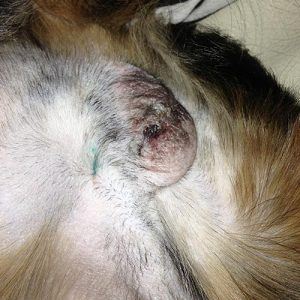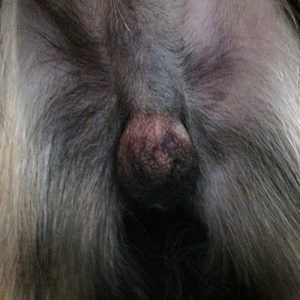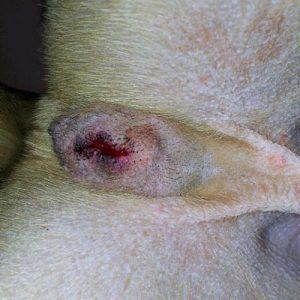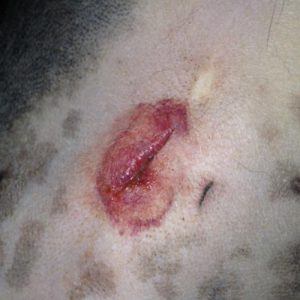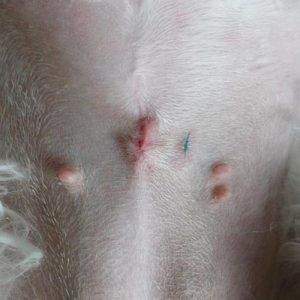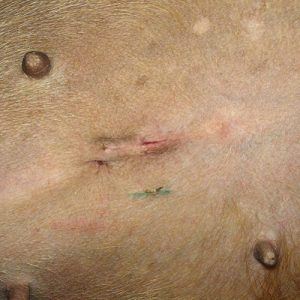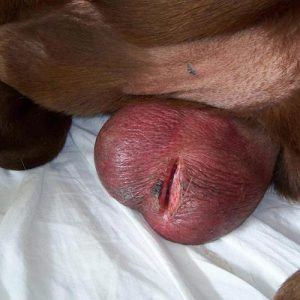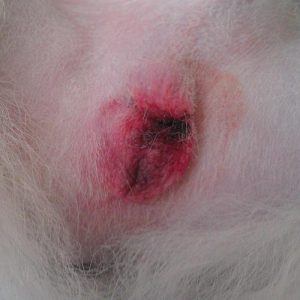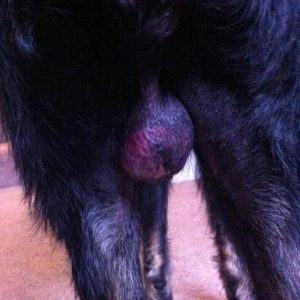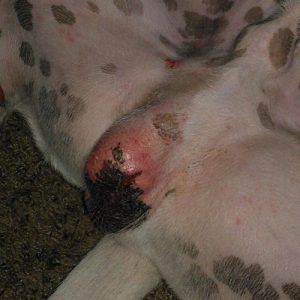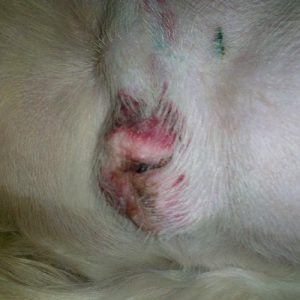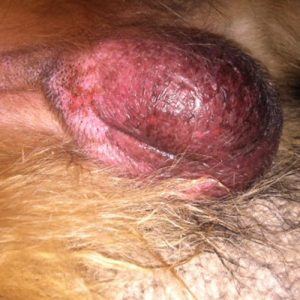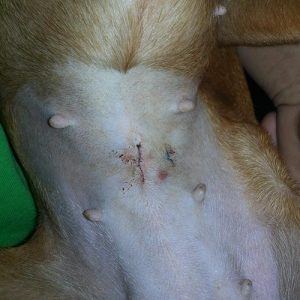Overview
Below you’ll find all of the information you need to prepare for postoperative care for your dog. We’ve also included frequently asked questions and related blog posts.
In general, Pets In Stitches will recheck your dog at no charge for complications resulting directly from surgery. There could be a charge for medications or an Elizabethan collar, if needed. Please be aware that some complications must be referred elsewhere. When in doubt, just give us a call text or send us a note and we will point you in the right direction.
Use these quick links to navigate to specific sections.
Spay or Neuter Care
Dr. Rastetter shares what all to expect in videos for both males and females. In addition, please read the following:
- Please keep females that were in heat away from non-neutered males for two (2) weeks. While they are unable to become pregnant, they will still attract males. If a male attempts to breed the female, it can cause life-threatening damage to the female.
- Male dogs can still impregnate a female dog for up to one month after surgery.
General Care
- It is very important to limit your dog’s activity for the next seven (7) days. Keep your dog quiet in a cage or a small room like a bathroom. No running, jumping, playing, or swimming. Very short leash walks for elimination only are allowed.
- If you are having difficulty keeping your dog inactive, please contact us regarding purchasing go-home anti-anxiety medication. If your dog is active, complications can occur such as failure of the internal sutures with life-threatening herniation or painful swelling at the surgical site.
- Your dog may or may not want to eat but should be eating by the morning after surgery.
- Your dog must be kept indoors to stay clean, dry, and warm. Do not bathe your dog during the recovery period.
- Side effects of anesthesia include sleepiness, mild disorientation, and extreme response to normal stimuli. You dog may be a little agitated or aggressive because of anesthesia. For this reason, we recommend isolating your dog from children and other pets.
Incision Care
- Check the incision site daily for the next seven (7) days. Redness and swelling should be minimal but can occur for a few days after surgery. Males may appear as if they still have testicles. This is normal swelling that will decrease gradually.
- There should be no drainage. Expect slight bleeding from the scrotum of a neutered male for the first 24 hours.
- Do not allow your dog to lick or chew at the incision. Your dog must wear the postoperative collar for at least one week, especially when unsupervised. If the collar is removed and the incision damaged, this is considered self-trauma and Pets In Stitches will not cover your costs to treat complications such as surgical site destruction, infection, or swelling which can require emergency care.
- No suture removal is necessary since incisions are held together with dissolvable sutures or glue.
- Do not clean or apply topical ointment to the incision site.
Healing Process
The following photos are visual examples of what you should encounter after surgery and days after having your dog spayed or neutered. If you see anything that looks unusual or you are concerned about, please don’t hesitate to give us a call.
The following photos are visual examples of improperly healing surgical sites after having your pet spayed or neutered. If your pet surgery was performed at Pets In Stitches, please contact us if your pet’s incision looks like any of these pictures.
Frequently Asked Questions
What should I do to keep my dog/cat from licking his/her incision?
You may purchase a post-surgery collar or body suit from us.
Should I be worried that my dog/cat is licking his/her incision?
Yes. Please bring them in so we can check their incision. We are available for rechecks Monday, Tuesday, Thursday and Friday with an appointment or follow the emergency contact instructions on your Postoperative Care Instruction sheet.
What is the green mark on my pet?
A small tattoo is the best way to identify your pet has been spayed or neutered. It is standard procedure for sterilization surgeries.
What is the recovery period like?
The recovery period is seven to ten days. You need to restrict their activity and keep them indoors. You also want to watch their incision closely. We will give you Postoperative Care Instructions when you pick up your pet.
Is the procedure painful?
Surgery is performed under general anesthesia with additional pain medication administered by a licensed Doctor of Veterinary Medicine. The animal is asleep during the procedure and may experience mild discomfort after surgery. Most animals return to normal activity within 24 to 72 hours. Pain medication is also sent home.
Is the surgery safe?
With any surgical procedure, there is always risk but we take every step possible to protect your pet. Your pet will be constantly monitored in person as well as with specialized monitoring equipment during surgery. Pets In Stitches uses an anesthetic protocol that is widely accepted in our field. A licensed veterinarian performs the surgery while the pet is under full anesthesia. Your pet will stay at our clinic for the day so we will be able to observe them during recovery.
Ovary Sparing Spay or Vasectomy Care
- Your dog received a green tattoo on their abdomen. This procedure identifies a dog as sterilized.
- Sex hormones remain and, thus, your dog will act, for all intents and purposes, as an intact dog minus the ability to become pregnant or sire a litter. Females need to be monitored closely for mammary masses which, if they occur, should be evaluated immediately by your full-service veterinarian.
- Vasectomies have a small chance of failure and, if that occurs, your male dog may sire puppies. You may have collections of reproductive fluids performed at your full-service veterinarians to determine success of vasectomy after three months. Until that is determined, please do not allow him access to females in season.
- Male dogs can still impregnate a female dog for up to one month after surgery.
- Your dog will received pain medication at the time of surgery and some to be administered at home in food.
General Care
- Please contact us immediately if you notice any of the following: pale gums, vomiting, diarrhea, discharge or bleeding from the incision, difficulty urinating, incision opens, labored breathing, lethargy lasting for more than 24 hours.
- It is very important to limit your dog’s activity for the next seven (7) days. Keep your dog quiet in a cage or a small room like a bathroom. No running, jumping, playing, or swimming. Very short leash walks for elimination only are allowed.
- If you are having difficulty keeping your dog inactive, please contact us regarding purchasing go-home anti-anxiety medication. If your dog is active, complications can occur such as failure of the internal sutures with life-threatening herniation or painful swelling at the surgical site.
- The anti-anxiety medication does not take the place of physically confining your dog. If your pet is too sedated after administration, administer a lower dose.
- Feed as normal the night of surgery. Your dog may or may not want to eat but should be eating by the morning after surgery.
- Your dog must be kept indoors to stay clean, dry, and warm. Do not bathe your dog during the recovery period.
- Side effects of anesthesia include sleepiness, mild disorientation, and extreme response to normal stimuli. You dog may be a little agitated or aggressive because of anesthesia. For this reason, we recommend isolating your dog from children and other pets.
Incision Care
- Check the incision site daily for the next seven (7) days. Redness and swelling should be minimal but can occur for a few days after surgery. This is normal swelling that will decrease gradually.
- There should be no drainage.
- Do not allow your dog to lick or chew at the incision. Your dog must wear the postoperative collar for at least one week, especially when unsupervised. If the collar is removed and the incision damaged, this is considered self-trauma and Pets In Stitches will not cover your costs to treat complications such as surgical site destruction, infection, or swelling which can require emergency care.
- If your dog allows, apply ice to their surgical site for 10 to 15 minutes several times a day for the first 48 hours. This will help reduce pain and swelling.
- No suture removal is necessary since incisions are held together with dissolvable sutures or glue.
- Do not clean or apply topical ointment to the incision site.
Healing Process
The following photos are visual examples of what you should encounter after surgery and days after having your dog spayed or neutered. If you see anything that looks unusual or you are concerned about, please don’t hesitate to give us a call.
The following photos are visual examples of improperly healing surgical sites after having your pet spayed or neutered. If your pet surgery was performed at Pets In Stitches, please contact us if your pet’s incision looks like any of these pictures.
Frequently Asked Questions
Should I be worried that my dog/cat is licking his/her incision?
Yes. Please bring them in so we can check their incision. We are available for rechecks Monday, Tuesday, Thursday and Friday with an appointment or follow the emergency contact instructions on your Postoperative Care Instruction sheet.
What should I do to keep my dog/cat from licking his/her incision?
You may purchase a post-surgery collar or body suit from us.
What is the green mark on my pet?
A small tattoo is the best way to identify your pet has been spayed or neutered. It is standard procedure for sterilization surgeries.
What is the recovery period like?
The recovery period is seven to ten days. You need to restrict their activity and keep them indoors. You also want to watch their incision closely. We will give you Postoperative Care Instructions when you pick up your pet.
Dental Care
General Care
- Please contact us immediately if you notice any of the following: pale gums, vomiting, diarrhea, labored breathing, or lethargy lasting for more than 24 hours.
- Feed as normal after surgery. Your pet might not want to eat right away but should be eating by the morning after surgery. Offering canned food or moistening dry food with water to soften can be helpful.
- Side effects of anesthesia include sleepiness, mild disorientation, and extreme response to normal stimuli. Your pet may be a little agitated or aggressive due to the effects of anesthesia. For this reason, we recommend isolating your pet from children and other pets.
- Your pet has received pain medication during the dental and, if extractions were performed, some to be administered at home.
Incision Care
- If your pet has extractions with sutures placed, check the incision sites daily for the next seven (7) days to make sure the incision edges haven’t separated. If a follow up appointment is needed, we will let you know at your pick up time.
- If extractions were performed, please feed soft food and no chew toys, rawhides, or mouth play for seven (7) days. Do not change your pet’s diet as it may cause GI upset. If your pet eats dry food, just soak dry food in warm water for half an hour.
- Dentals are very safe surgeries; however, complications can occur. Minimal discomfort should resolve within several days. If discomfort persists longer, please contact us.
Frequently Asked Questions
What forms of dental surgery do you offer?
Routine scale and polish, extractions, excessive gum growth removed.
What forms of payments do you take?
We accept cash, credit cards or debit cards and Care Credit. We do not accept personal checks.
A 4% service fee is applied to all sales. We do offer a full discount on this service fee to customers who pay with cash.
Why can you provide surgical services at a cost less than most full-service practices?
Pets in Stitches is a streamlined practice. Unlike a private veterinarian who provides a full medical service, we are focused on one single service, i.e. quality surgeries. Pets In Stitches performs surgery along with basic vaccinations and testing only. With our singular focus, we can better maintain our overhead costs, making it more affordable.
If my pet is showing signs of illness, should I postpone surgery or vaccinations?
Please call us. Some conditions do not interfere with surgery and some do require surgery be delayed.
Use these quick links to navigate to specific sections.

